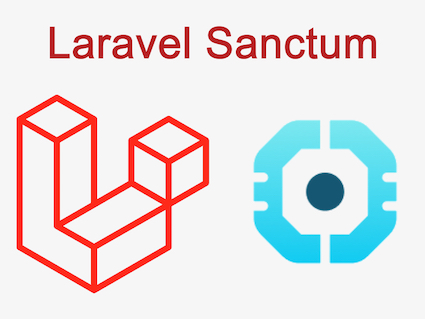

This is a solution for an authentication system.
The idea is to have an API service that only returns data in JSON format (backend) and a serverless system that fetches the data from the API and presents the information to the user through the frontend.
The chosen authentication system is Sanctum.
The other option would be Passport, which provides a complete implementation of OAuth2. However, since we want to test a mixed authentication system (API + website sessions), and considering that Sanctum also manages tokens and can be used for APIs, the choice fell on the latter.
There is a component where even though the user is authenticated, the display of certain pages is only for administrators.
It was defined to store the access token in local storage because it provides a convenient and efficient method for client-side storage, allowing easy access and retrieval of the token for authentication purposes across different parts of the application without the need for server-side sessions. Additionally, local storage offers more storage space compared to cookies, and it is not sent with every HTTP request, reducing the risk of interception by malicious parties.

All API routes have security measures such as rate limiting, where a maximum number of requests is defined. If the user exceeds this limit, the API returns 429 (Too Many Requests).
In the frontend during development, all scripts and styles are loaded separately file by file. In production, all documents are compressed and minified into a single app.js and app.css file, resulting in only 2 loads because they are then cached.
A JavaScript module with AJAX was developed to handle communication and request management with the API.
It was defined the storage of scripts and styles are organized based on a definition of local/prod environment, where in the prod environment there is only one JS and one CSS document, and in dev all files are separated and not minified.
It was also defined that style in the storage of scripts and styles within the previous step, are also inside a sub-category where it is also organized based on a definition of public/private, representing documents loaded in public and private areas.
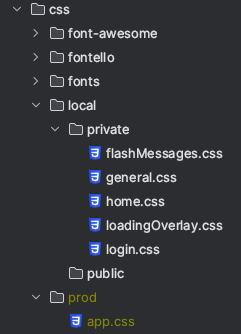
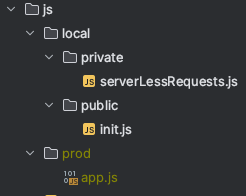
Users who are already authenticated with a valid token, if they reach the login page, are automatically redirected to the private area.
A TTL (Time-to-Live) was defined in the frontend to renew the access token.
A TTL in the API side is a development in progress to renew the access token, as Sanctum don´t has a native way to renew the access_tokens.
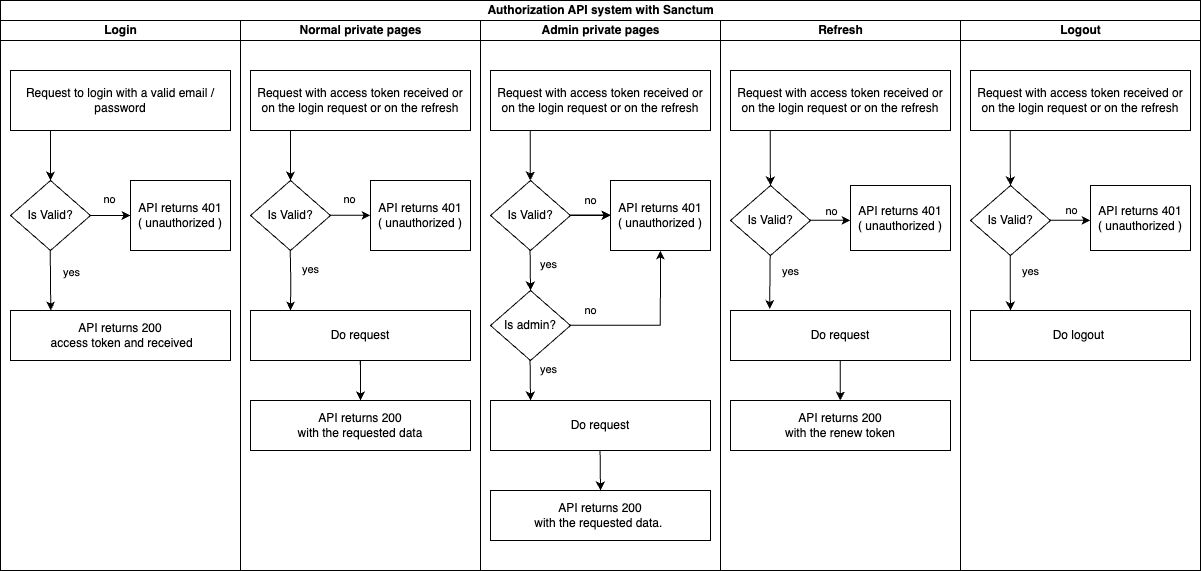
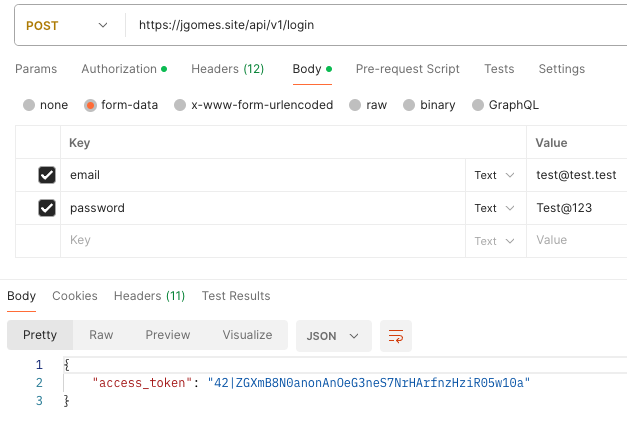
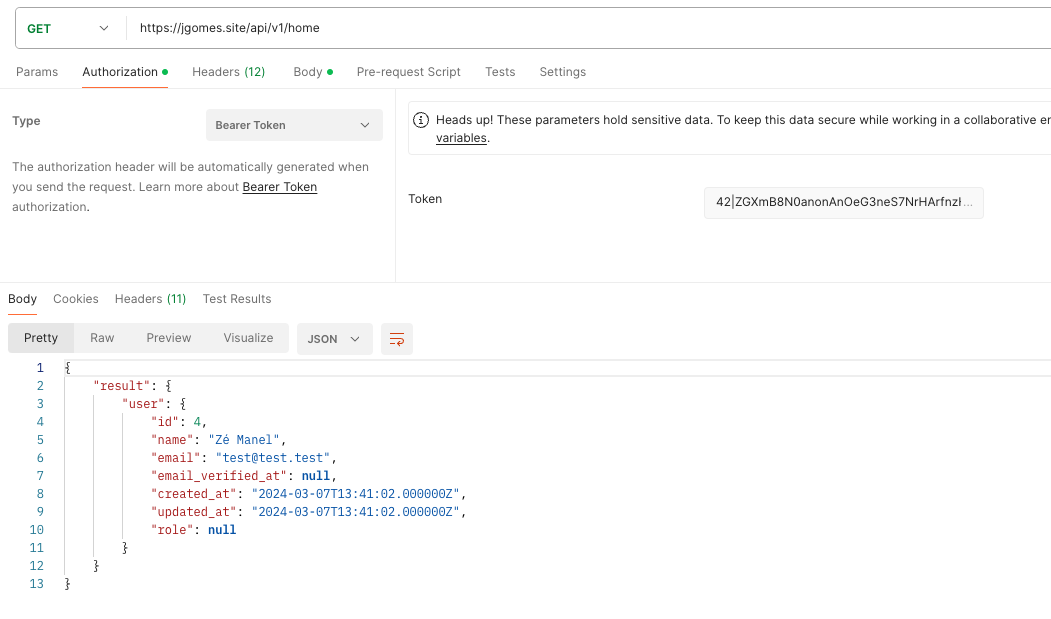
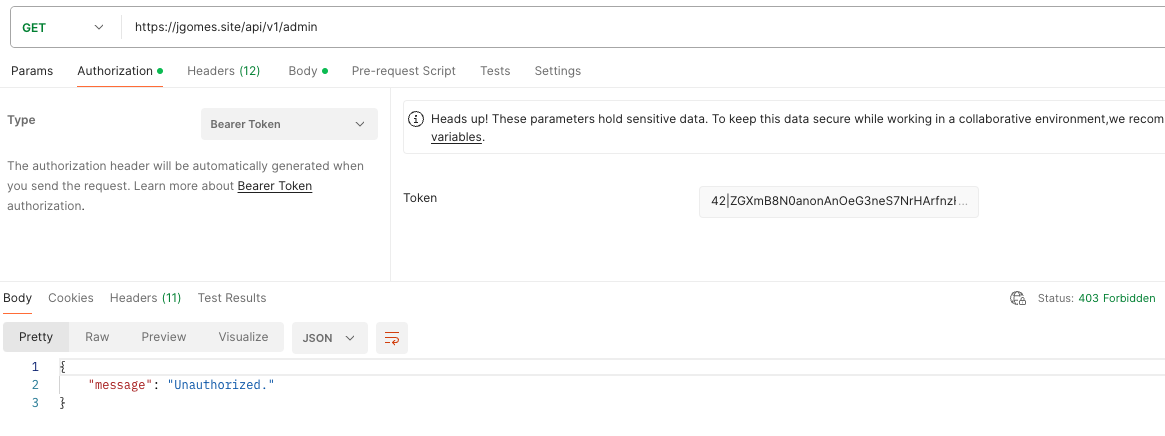


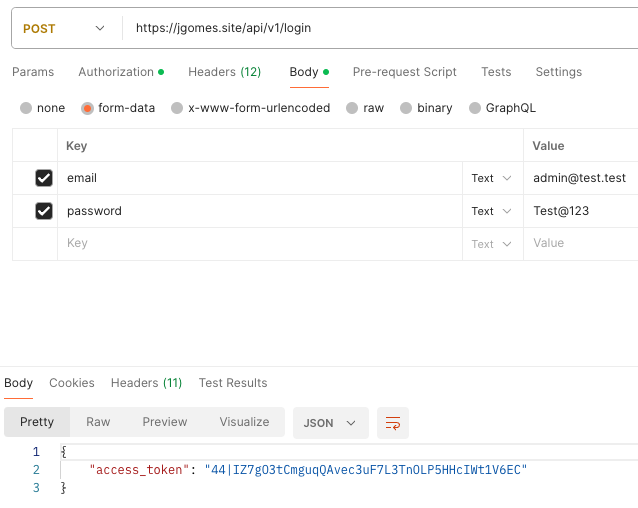
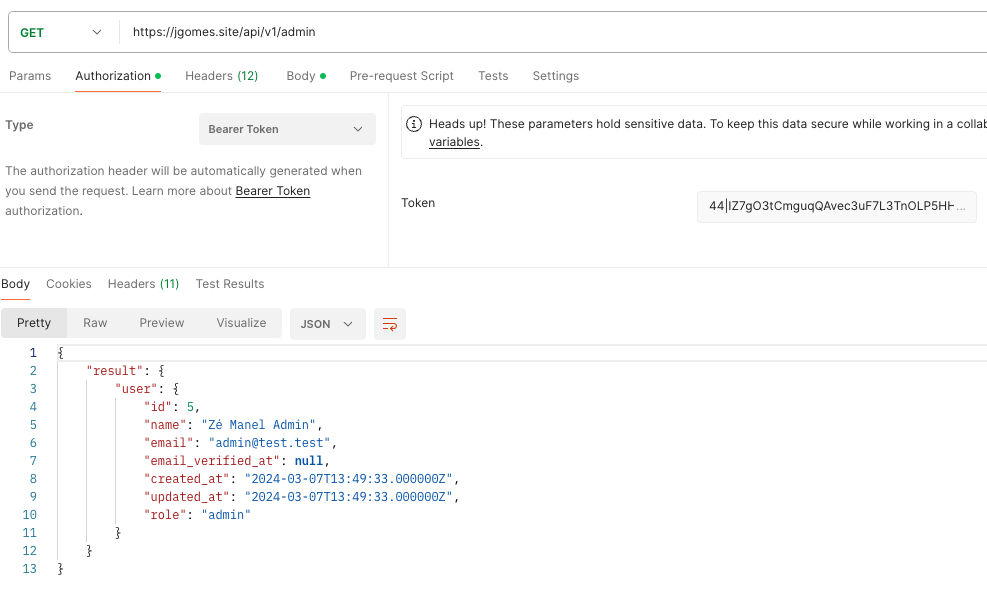
<?php
namespace App\Http\Controllers;
use Illuminate\Http\Request;
use Illuminate\Http\JsonResponse;
use Illuminate\Support\Facades\Auth;
class AuthController extends Controller
{
/**
* @param Request $request
* @return JsonResponse
*/
public function login(Request $request): JsonResponse
{
$credentials = $request->only('email', 'password');
if (Auth::attempt($credentials))
{
// Create token
$accessToken = Auth::user()
->createToken('MyApp')
->plainTextToken;
return response()->json([
'access_token' => $accessToken
]);
}
// Invalid credentials
return response()->json(
[
'error' => 'Unauthorized'
],
401
);
}
/**
* @param Request $request
* @return JsonResponse
*/
public function logout(Request $request): JsonResponse
{
// Revoke all tokens
$request->user()->tokens()
->delete();
return response()->json(
[
'message' => 'Successfully logged out'
]
);
}
/**
* @param Request $request
* @return JsonResponse
*/
public function refresh(Request $request): JsonResponse
{
// Revoke all tokens except the current one
$request->user()->tokens()
->where('id', '<>', $request->user()->currentAccessToken()->id)
->delete();
// Create a new token
$accessToken = $request->user()
->createToken('MyApp')
->plainTextToken;
return response()->json(
['access_token' => $accessToken]
);
}
/**
* @param Request $request
* @return JsonResponse
*/
public function user(Request $request): JsonResponse
{
return response()->json($request->user());
}
/**
* @param Request $request
* @return JsonResponse
*/
public function check(Request $request): JsonResponse
{
$result = false;
if (!is_null($request->user())) {
$result = true;
}
return response()->json($result);
}
}
Route::prefix('v1')->group(function () {
// Allow 10 tries to log in per min
Route::middleware('throttle:10,1')->group(function () {
Route::post('/login',
[
AuthController::class, 'login'
]
)->name('login');
});
// Protected routes by Sanctum
Route::middleware('auth:sanctum')->group(function ()
{
// Allow a margin of 3 logouts per min as it should run once a time
Route::middleware('throttle:10,1')->group(function () {
Route::post('/logout',
[
AuthController::class, 'logout'
]
)->name('logout');
});
// Allow a margin of 5 refresh per min, as it only suppose to run rarely
Route::middleware('throttle:5,1')->group(function () {
Route::post('/refresh',
[
AuthController::class, 'refresh'
]
)->name('refresh');
});
// Allow 5 refresh per min, as it will be cached
Route::middleware('throttle:5,1')->group(function () {
Route::post('/user',
[
AuthController::class, 'user'
]
)->name('user');
});
// Check if user is authenticated...
// This route will be cached... No need more than 1 non cached access per minute
Route::get('/check',
[
AuthController::class, 'check'
]
)->name('check');
// Private home page. Let's allow 30 accesses per min
Route::middleware('throttle:30,1')->group(function () {
Route::get('/home',
[
HomeController::class, 'index'
]
)->name('home.index');
});
// Allow only admin
Route::middleware(['checkRole:admin', 'throttle:20,1'])->group(function () {
Route::get('/admin',
[
AdminController::class, 'index'
]
)->name('admin');
});
});
});
// Allow only admin
Route::middleware(['checkRole:admin', 'throttle:20,1'])->group(function () {
Route::get('/admin',
[
AdminController::class, 'index'
]
)->name('admin');
});
<?php
namespace App\Http\Middleware;
use Closure;
class CheckUserRole
{
public function handle($request, Closure $next, ...$roles)
{
$user = auth()->user();
if ($user && in_array($user->role, $roles)) {
return $next($request);
}
abort(403, 'Unauthorized.');
}
}

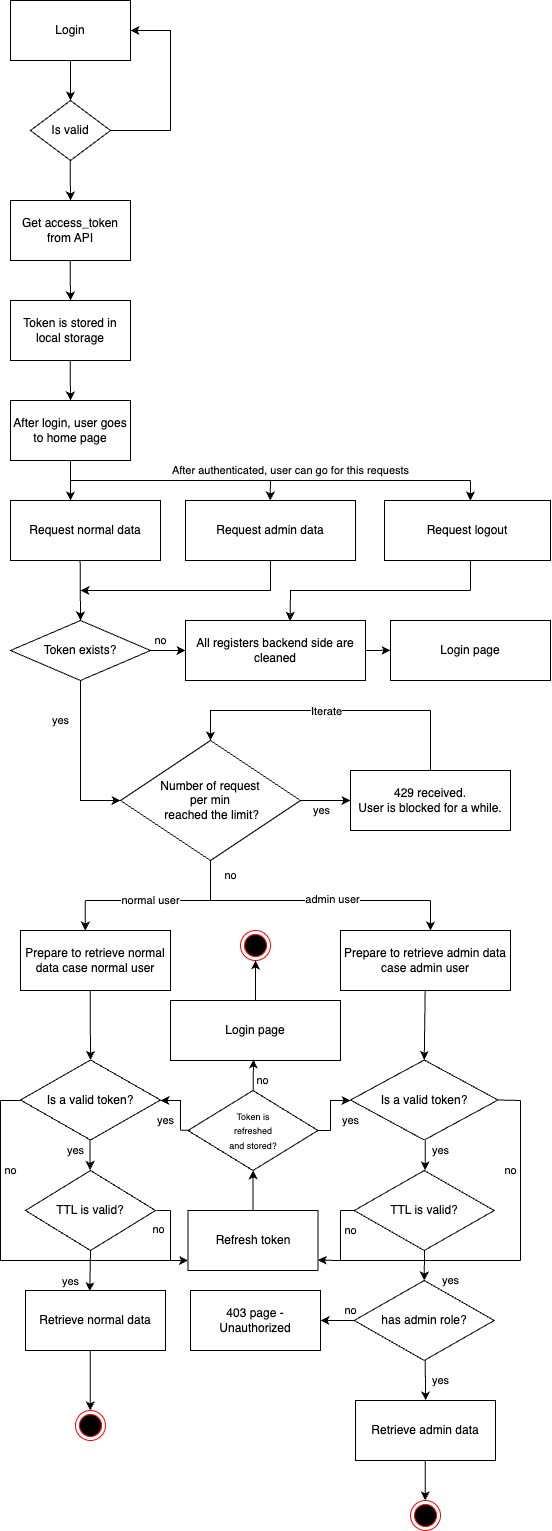
// Access token name
let access_token_str = 'access_token';
// Access token ttl
let access_token_ttl_minutes = 15;
// Login page
let login_page = '/login';
// Home page
let home_page = '/home';
// Forbidden page
let forbidden_page = '/403';
// Too many requests page
let many_requests_page = '/429';
// Ajax requests module definition
let serverLessRequests = (function($)
{
// Login function
function doLogin()
{
// Had the overlay
$("#overlay").show();
// Authenticate
$.ajax({
type: 'POST',
url: '/api/v1/login',
data: $('#loginForm').serialize(),
success: function(response)
{
// Store the access_token at localStorage
setTokenWithExpiry(access_token_str, response.access_token, access_token_ttl_minutes);
// Handle successful login - redirect to home
window.location.href = `${home_page}`;
},
error: function(xhr)
{
// Remove the overlay
$("#overlay").hide();
// Inform client about 429 ( Too many requests )
if (xhr.status !== 429)
{
// Show error to client
showFlashMessage(
'error',
'Invalid login'
);
return;
}
// Show error to client
showFlashMessage(
'error',
'Too many request at this moment'
);
}
});
}
// Bypass login case client has a valid token
function checkAuthAndByPassLogin()
{
// Wait for the promise to be resolved
getToken(access_token_str)
.then((token) => {
// Case no token stored or token is invalid, redirect to home_page
if (!token) {
window.location.href = `${login_page}`;
} else {
// Token is valid, redirect to home_page or perform other actions
window.location.href = `${home_page}`;
}
})
.catch(() => {
// Here we can handle the error appropriately (e.g., redirect to somewhere)
});
}
// Logout function
function doLogout()
{
// Had the overlay
$("#overlay").show();
// Wait for the promise to be resolved
getToken(access_token_str)
.then((token) => {
$.ajax({
type: 'POST',
url: '/api/v1/logout',
headers: {
'Authorization': `Bearer ${token}`
},
success: function() {
// Handle success if needed
},
error: function(xhr) {
// Handle error if needed
},
complete: function() {
// Remove client token stored in the browser
localStorage.removeItem(access_token_str);
// Redirect to login page
window.location.href = `${login_page}?` + btoa('b64=true&success=Logout done with success');
}
});
})
.catch(() => {
// Here we can handle the error appropriately (e.g., redirect to an error page)
});
}
// Get data if authorized
function checkAuthAndGetData(url)
{
// Had the overlay
$("#overlay").show();
// Wait for the promise to be resolved
getToken(access_token_str)
.then(token => getData(url, token))
.then(response => {
// Handle successful data retrieval
// console.log(response);
if(response.result.user.role === 'admin')
{
$(".adminLink").show();
}
})
.catch(error => {
// Case forbidden (403) errors go to forbidden page
if (error === 403)
{
window.location.href = forbidden_page;
// Case too many requests (429) errors go to many requests page
} else if (error === 429)
{
window.location.href = many_requests_page;
} else {
// Case other errors redirect to login page
window.location.href = `${login_page}?` + btoa(`b64=true&error=${error}`);
}
})
.finally(() => {
// Hide the overlay regardless of success or failure
$("#overlay").hide();
});
}
// Function to get data from backend with a valid token
function getData(url, token)
{
return new Promise(function(resolve, reject)
{
$.ajax({
type: 'GET',
url: url,
headers: {
'Authorization': `Bearer ${token}`
},
success: function(response)
{
resolve(response);
},
error: function(xhr)
{
// Case Forbidden go back
if (xhr.status === 403)
{
reject(403);
return;
}
// Inform client about 429 ( Too many requests )
if (xhr.status === 429)
{
// Reject the promise for too many requests
reject(429);
return;
}
// xhr.statusText || 'Cannot load data. Please try again.'
reject('Cannot load data');
}
});
});
}
// Function to create and show errors
function showFlashMessage(type, message) {
$('<div>', {
class: 'flashMessage ' + type,
text: message
}).prependTo('#loginMsg').delay(3000).fadeOut(1000, function() {
$(this).remove();
});
}
// Function to set the token in localStorage with an expiration time
function setTokenWithExpiry(key, value, ttlInMinutes)
{
let now = new Date();
let item = {
value: value,
expiry: now.getTime() + ttlInMinutes * 60 * 1000, // Converting minutes to milliseconds
};
localStorage.setItem(key, JSON.stringify(item));
}
// Function to retrieve a new token from localStorage
function doRefreshToken(oldToken)
{
return new Promise((resolve, reject) => {
$.ajax({
type: 'POST',
url: '/api/v1/refresh',
headers: {
'Authorization': `Bearer ${oldToken}`
},
success: function (response) {
// Store the access_token at localStorage
setTokenWithExpiry(access_token_str, response.access_token, access_token_ttl_minutes);
// Return the new token
resolve(response.access_token);
},
error: function (xhr) {
// Inform client about 429 ( Too many requests )
if (xhr.status !== 429) {
// Reject the promise as the token refresh failed
reject('Authentication needed');
return;
}
reject('Too many requests');
}
});
});
}
// Function to return the current token from localStorage and case it is expired, create a new one
function getToken(key)
{
return new Promise((resolve, reject) => {
// Check if token is stored in localStorage
let accessToken = localStorage.getItem(key);
// If localStorage is empty, reject the promise as the no token was not found
if (!accessToken)
{
reject('Authentication needed');
return;
}
// Extract token and expiration date
let access_token = JSON.parse(accessToken);
// Current date
let now = new Date();
// Get current token
let token = access_token.value;
// Compare current date with the token validation date. If the token expired, delete the current localStorage
if (now.getTime() > access_token.expiry) {
// Use the promise returned by doRefreshToken to create a new token and store it in localStorage
doRefreshToken(token)
.then((newToken) => {
resolve(newToken);
})
.catch((error) => {
reject(error);
})
} else {
// Last check... check if the current token is valid
$.ajax({
type: 'GET',
url: '/api/v1/check',
headers: {
'Authorization': `Bearer ${token}`
},
success: function() {
resolve(token);
},
error: function(xhr) {
// Remove the token fom localStorage if it is invalid.
// Allow to keep 429 ( Too many requests )
if (xhr.status !== 429) {
// Remove the token from localStorage if it is invalid.
localStorage.removeItem(key);
// Reject the promise as the refresh token is invalid
reject('Authentication needed');
return;
}
// Reject the promise for too many requests
reject('Too many requests');
}
});
}
});
}
// Init the module...
// Assigning events to HTML elements, initializing other functions, etc...
function init()
{
// Login btn via click
$('#loginBtn').on('click', doLogin);
// Login btn via btn enter
$(document).on('keypress', function(event) {
if (event.which === 13) { // Enter btn code
event.preventDefault();
doLogin(); // Call the func doLogin
}
});
// Bypass login page case user has a valid access_token
if (window.location.pathname === `${login_page}`)
{
checkAuthAndByPassLogin();
}
// Set time to remove flash messages
$('.flashMessage').delay(3000).fadeOut(1000);
}
// Return init
return {
init: init,
checkAuthAndGetData: checkAuthAndGetData,
doLogout: doLogout
};
})(jQuery);
// Route to authenticate
Route::get('/login', function () {
return view('auth.login);
})
->name('auth.login');
// Route for authenticated user
Route::get('/home', function () {
return view('home.index');
})
->name('home.index');
// Route for 'admin' rule
Route::get('/admin', function () {
return view('admin.index');
})
->name('admin.index');
// Route for '403' message
Route::get('/403', function () {
return view('errors.403');
})
->name('error.403');
// Route for '429' message
Route::get('/429', function () {
return view('errors.429');
})
->name('error.429');